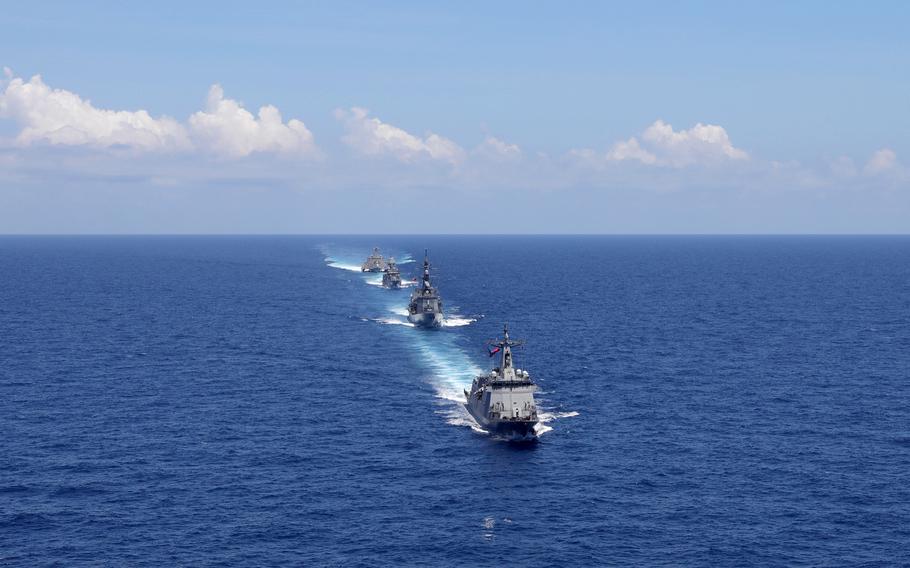
The U.S., Australia, Japan and the Philippines train in the South China Sea, within the Philippines' exclusive economic zone, Sunday, April 7, 2024. (U.S. Navy)
The United States and three allies sent five warships and two aircraft to the South China Sea on Sunday, a move meant to discourage Beijing and others from using force and coercion in the region, according to one security expert.
Forces from the U.S., Australia, Japan and the Philippines rendezvoused in the Philippines’ exclusive economic zone for a “maritime cooperative activity,” with drills in communication, division tactics and formation training, said U.S. 7th Fleet spokesman Lt. Luka Bakic.
It allowed the crews to strengthen their “doctrines, tactics, techniques and procedures,” he told Stars and Stripes by email Monday. He did not elaborate on exactly where the drills took place in the South China Sea.
In response, China held its own “joint naval and air combat patrol” in the area on Sunday, the country’s Southern Theater Command said in a Sunday post to the social media website Weibo.
Two Chinese navy ships came as close as about 7 miles from the area where the four-power exercise occurred, according to a post Monday on X, formerly Twitter, by Philippine network ABS-CBN News. It cited Armed Forces of the Philippines chief Gen. Romeo Brawner Jr. as the source.
Bakic did not specify whether the U.S. or its allies interacted with Chinese forces, except to say U.S. forces “routinely interact with foreign warships and aircraft” in the region.
“All interactions with foreign military forces were consistent with international norms,” he wrote.
A Japan Maritime Self-Defense Force spokesman by phone Monday said he was aware of reports about Chinese ships patrolling the area that day, but he declined further comment.

The U.S., Australia, Japan and the Philippines train in the South China Sea, within the Philippines' exclusive economic zone, Sunday, April 7, 2024. (U.S. Navy)
The four nations’ defense chiefs said the exercise upholds international rights to freedom of navigation, according to a Defense Department news release Friday.
The drills also demonstrated “active presence, solidarity and coordination among U.S. allies in East Asia and the Indo-Pacific,” said Ja Ian Chong, associate professor of political science at the National University of Singapore.
“They aim to discourage [China] and any other actor, including North Korea and Russia from challenging the prevailing order through force or coercion,” he told Stars and Stripes by email Monday.
While there’s friction between the U.S. and China, they’ve managed to avoid “uncontrolled escalation,” Chong said.
“So long as this mutual understanding holds, there could be some hope for a basic level of stability,” he added.
The littoral combat ship USS Mobile and a U.S. Navy P-8A Poseidon maritime patrol and reconnaissance aircraft joined the Australian frigate HMAS Warramunga, an Australian air force P-8A Poseidon, the Japanese destroyer JS Akebono, and the Philippine frigate BRP Antonio Luna and patrol ship BRP Valentin Diaz for the exercise, according to the Maritime Self-Defense spokesman.
It was the first of its kind between the four nations, he told Stars and Stripes by phone Monday.
Some Japanese government spokespeople may speak to the media only on condition of anonymity.
No official statement on the exercise directly mentioned China, an intentional move “designed to keep the rhetoric restrained,” said Carlyle Thayer, an emeritus professor at the University of New South Wales at the Australian Defence Force Academy.
The exercise’s message “was clearly aimed at Beijing,” he told Stars and Stripes by email Monday.
Exclusive economic zones are typically within 230 miles of territorial seas and allow a country to claim jurisdiction over all present resources. China contests the Philippines’ EEZ and asserts claims on nearly all the South China Sea.
A 2016 intergovernmental tribunal upheld Philippine EEZ claims over China’s under the United Nations Convention on the Law of the Sea, a ruling Beijing does not recognize.
Second Thomas Shoal, a feature in the South China Sea, has become a flashpoint for that dispute.
As recently as March 23, Chinese and Philippine coast guard ships have faced off near the shoal — often with Chinese vessels intercepting or blocking Philippine ships sent to resupply a small outpost there.